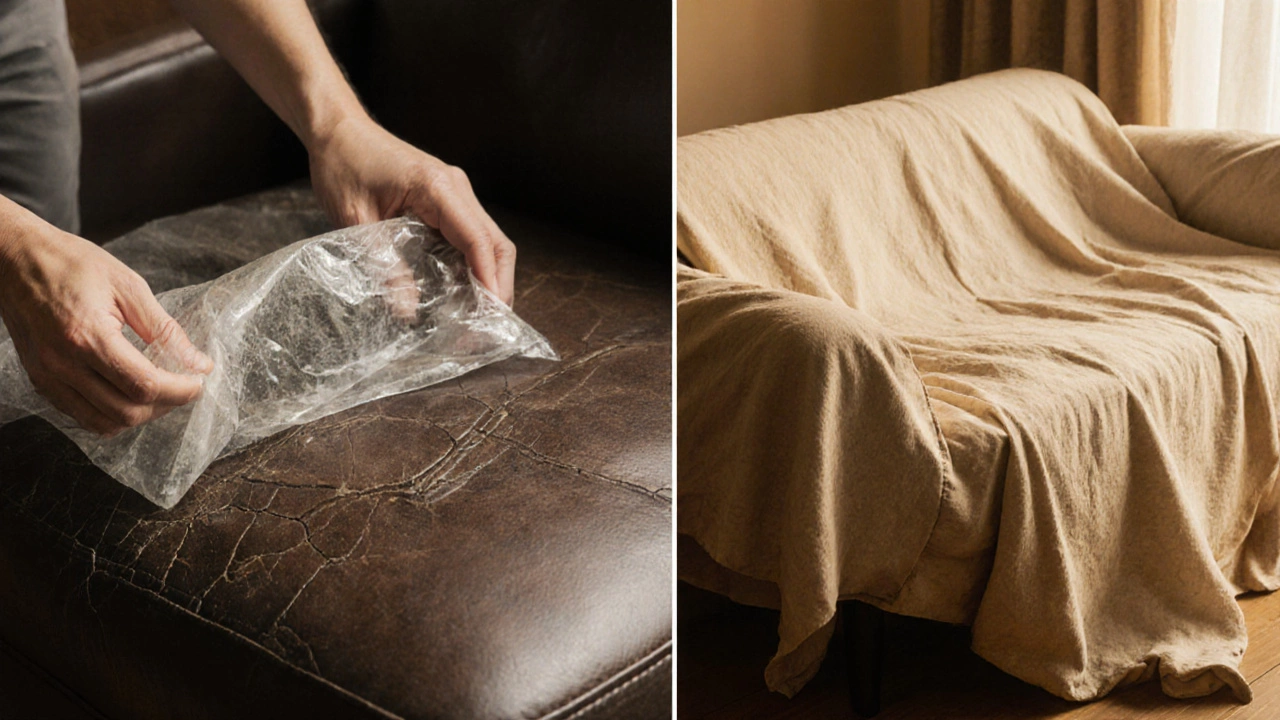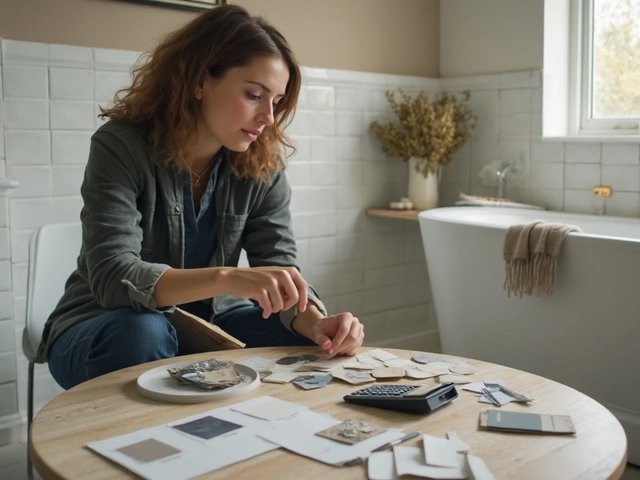Furniture Storage Cover Calculator
Choose Your Furniture Type
Recommended Cover
Cover Type:
Material:
Size Guide:
Storage Conditions:
Storing furniture doesn’t mean just tossing it into a unit and hoping for the best. If you’ve ever opened a storage unit to find a sofa covered in dust, a wooden table with scratches, or a mattress smelling like mildew, you know how easy it is to damage your stuff-even with good intentions. Covering furniture for storage isn’t about aesthetics; it’s about protection. And done right, it can save you hundreds-or even thousands-of dollars in repairs or replacements.
Why Covering Furniture Matters
Storage units aren’t climate-controlled by default. Even if they are, humidity, temperature swings, pests, and dust still find a way in. Leather cracks. Wood warps. Fabric attracts moths. Metal rusts. And once damage sets in, it’s often permanent.
Take a wooden dining table, for example. If you leave it uncovered in a damp garage or basement, moisture seeps into the grain. Over weeks, the finish bubbles. The legs swell. You might not notice until you pull it out six months later-and by then, refinishing it costs more than buying a new one.
Same goes for upholstered furniture. Dust doesn’t just look bad-it acts like sandpaper over time. And if there’s any moisture in the air? Mold grows fast. One study from the University of Washington found that uncovered fabric in unclimate-controlled storage showed visible mold growth in as little as 45 days.
Proper covering stops all that. It’s not optional. It’s basic care.
What to Use: The Right Covers for Each Type
Not all covers are created equal. Using the wrong one can trap moisture or scratch surfaces. Here’s what works for different furniture types:
- Canvas or cotton drop cloths - Best for wood, metal, and solid-frame pieces. Breathable, durable, and won’t trap humidity. Avoid plastic on these.
- Non-woven polypropylene furniture covers - Ideal for sofas, armchairs, and mattresses. They’re water-resistant, breathable, and come with zippers for full enclosure. Look for ones labeled "storage-grade"-not just "moving" covers.
- Plastic sheeting (only for short-term or dry environments) - Avoid unless you’re storing in a dry, climate-controlled space. Plastic traps moisture like a greenhouse. If you must use it, pair it with a breathable cotton layer underneath.
- Furniture pads or moving blankets - Great for wrapping legs, corners, and edges. Use these under your main cover to prevent scratches.
- Zippered mattress covers - Not just for protection from dirt. They seal out dust mites, bed bugs, and moisture. Get ones with a full zipper and airtight seal.
Don’t use trash bags. They’re thin, tear easily, and trap moisture. They’re also not UV-resistant, so sunlight can degrade them quickly.
Step-by-Step: How to Cover Furniture Properly
Covering furniture isn’t just draping a sheet over it. It’s a process. Do it right the first time.
- Clean everything first. Dust, crumbs, pet hair, and spills become problems under cover. Wipe down wood with a damp cloth and dry immediately. Vacuum upholstery. Spot-clean stains with a mild detergent. Let everything dry completely-wet furniture in storage = mold.
- Disassemble where possible. Take off table legs, detach chair arms, remove drawers from dressers. This reduces stress on joints and saves space. Wrap screws and hardware in labeled ziplock bags and tape them to the piece.
- Wrap fragile parts. Use moving blankets or foam corner protectors on sharp edges, glass tops, or delicate carvings. Secure with packing tape, but never directly on wood finishes.
- Place on pallets or risers. Never put furniture directly on a concrete floor. Moisture rises. Use wooden pallets, plastic furniture risers, or even thick cardboard. Elevating by just 2 inches makes a huge difference.
- Apply the cover. Drape the cover loosely. Don’t stretch it tight. Tight covers pull on seams and can warp frames. Use ties, straps, or Velcro to secure it-never rubber bands. They degrade and leave marks.
- Leave breathing room. Don’t stack covered items directly on top of each other. Air needs to circulate. If you must stack, place a breathable moving blanket between layers.

Storage Environment: Location Is Everything
Even the best cover won’t save your furniture if the storage space is wrong.
Climate-controlled units are the gold standard. They keep temperature between 55°F and 80°F and humidity below 55%. If you’re storing furniture in Vancouver’s damp winters, this isn’t a luxury-it’s a necessity.
If you’re using a garage, shed, or basement, check for:
- Condensation on walls or floors
- Signs of pests (droppings, chewed wood, webs)
- Water stains or leaks
Use a hygrometer to monitor humidity. If it’s above 60%, add a dehumidifier or silica gel packs. Place them in corners and near upholstered items. One 2-ounce pack lasts about 3 months.
Avoid direct sunlight. UV rays fade fabric and dry out leather. If your storage unit has windows, cover them with blackout curtains or cardboard.
What to Avoid
Here are the most common mistakes people make-and how to skip them:
- Using plastic wrap on fabric - Traps moisture. Causes mildew. Never do this.
- Stacking heavy items on sofas - Springs compress and lose shape permanently. Store sofas upright if possible.
- Leaving drawers full - Weight causes warping. Empty them. Pack contents separately.
- Storing leather in direct contact with plastic - Leather needs to breathe. Use cotton covers only.
- Ignoring seasonal changes - If you’re storing through winter, check for condensation in spring. If you’re storing through summer, watch for humidity spikes.

Long-Term Storage: Monthly Check-Ins
Don’t just lock the door and forget it. Every 30 to 60 days, take 10 minutes to inspect your stored pieces.
Open a cover. Smell it. Look for:
- Musty odors
- Discoloration on fabric or wood
- Moisture under the cover
- Pests or webs
If you find anything, act fast. Air out the piece. Replace the cover. Add more silica packs. A small fix now prevents a big loss later.
What to Do After Retrieving Furniture
When you bring your furniture back into your home, don’t just unwrap it and plop it down.
- Let it air out for 24-48 hours in a dry, ventilated room.
- Wipe down all surfaces with a microfiber cloth.
- Check for hidden damage-especially under cushions and along baseboards.
- Recondition leather with a pH-balanced cleaner and conditioner.
- Polish wood with a natural oil-based product.
Don’t rush. Furniture that’s been stored needs time to adjust to your home’s environment.
Final Thoughts: It’s an Investment, Not a Chore
Covering furniture for storage isn’t about being neat. It’s about protecting your investment. A good sofa, a solid oak dining set, or a vintage dresser can last decades-if you treat them right.
Spending $20 on proper covers and $10 on silica packs saves you $800 on replacing a damaged piece. That’s not saving money. That’s smart planning.
Start today. Clean it. Cover it. Elevate it. Check it. Your future self will thank you.
Can I use plastic sheeting to cover my furniture for storage?
Only if the storage space is completely dry and climate-controlled. Plastic traps moisture, which leads to mold, mildew, and warping. For most situations, especially in humid climates like Vancouver, plastic is a bad choice. Use breathable cotton or non-woven polypropylene covers instead.
Should I remove drawers from dressers before storage?
Yes. Drawers left in place can warp under their own weight, especially in humid conditions. Remove them, wrap them separately in moving blankets, and store them flat or upright next to the dresser. Label each drawer and tape the label to the frame.
How often should I check on stored furniture?
Every 30 to 60 days. Even if you’re storing for just a few months, check for signs of moisture, odor, or pests. A quick inspection takes 5 minutes but can prevent costly damage. Use a hygrometer to monitor humidity levels in the storage unit.
Is it okay to store furniture in a garage?
It’s possible, but risky. Garages often have temperature swings and high humidity. If you must store furniture in a garage, elevate it on pallets, use breathable covers, add silica gel packs, and monitor humidity with a meter. Avoid storing leather, wood, or upholstered items in unheated garages during winter.
What’s the best way to protect a leather sofa during storage?
Clean it with a pH-balanced leather cleaner first, then condition it with a natural oil-based product. Cover it with a breathable cotton or non-woven fabric cover-never plastic. Store it upright in a climate-controlled space with humidity below 55%. Check it monthly for cracks or dryness.








